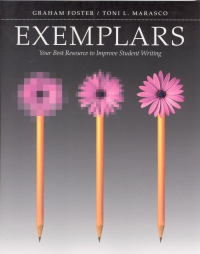| ________________
CM . . .
. Volume XIV Number 12 . . . .February 8, 2008
excerpt:
Over the last decade or so, education has seen a rise in the popularity of the rubric. Rubrics are set levels of criteria that teachers use to assess or evaluate student work. But rubrics can be vague and often contain much educational jargon that makes them difficult to understand for many adults, let alone students. Exemplars are examples of student work. Combining rubrics and exemplars allows students not only to know the assessment criteria for a writing task, but also what a finished piece of writing looks like at the different levels. Rubrics tell, but exemplars show. This complementary rubric/exemplar combination allows students to use assessment criteria as well as examples to improve their own writing. That is the premise that Foster and Marasco present in Exemplars: Your Best Resource to Improve Student Writing. Foster and Marasco's Exemplars: Your Best Resource to Improve Student Writing is organized around the six traits of writing model (content, organization, sentence variety, word choice, voice, and conventions). For each of the six traits, Foster and Marasco include a number of lesson plans that use exemplars as the key teaching strategy. Exemplars are clearly presented in blackline master format, ready to be copied or created into overheads. There is a good deal of variety used in the lessons. For example, in some lessons, students work with a single exemplar and learn how to improve it while, in others, students work with two exemplars, each created by a different student, and they must then compare the two exemplars. The exemplars in the book also cover a variety of writing genres including letter writing, persuasive writing, and story writing. While Exemplars: Your Best Resource to Improve Student Writing is not grade specific, it is suitable and could easily be adapted for any junior and intermediate grade. Recommended. Kristen Ferguson teaches Language Arts at the Faculty of Education at Nipissing University and is a doctoral student in Education at York University.
To comment
on this title or this review, send mail to cm@umanitoba.ca.
Copyright © the Manitoba Library Association. Reproduction for personal
use is permitted only if this copyright notice is maintained. Any
other reproduction is prohibited without permission.
NEXT REVIEW |
TABLE OF CONTENTS FOR THIS ISSUE
- February 8, 2008.
AUTHORS |
TITLES |
MEDIA REVIEWS |
PROFILES |
BACK ISSUES |
SEARCH |
CMARCHIVE |
HOME |
